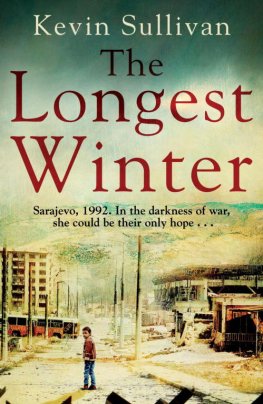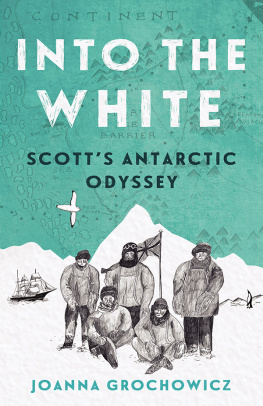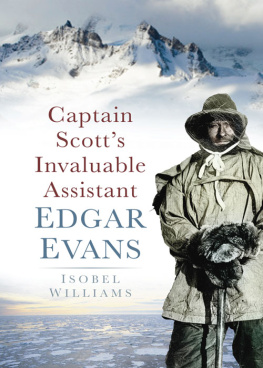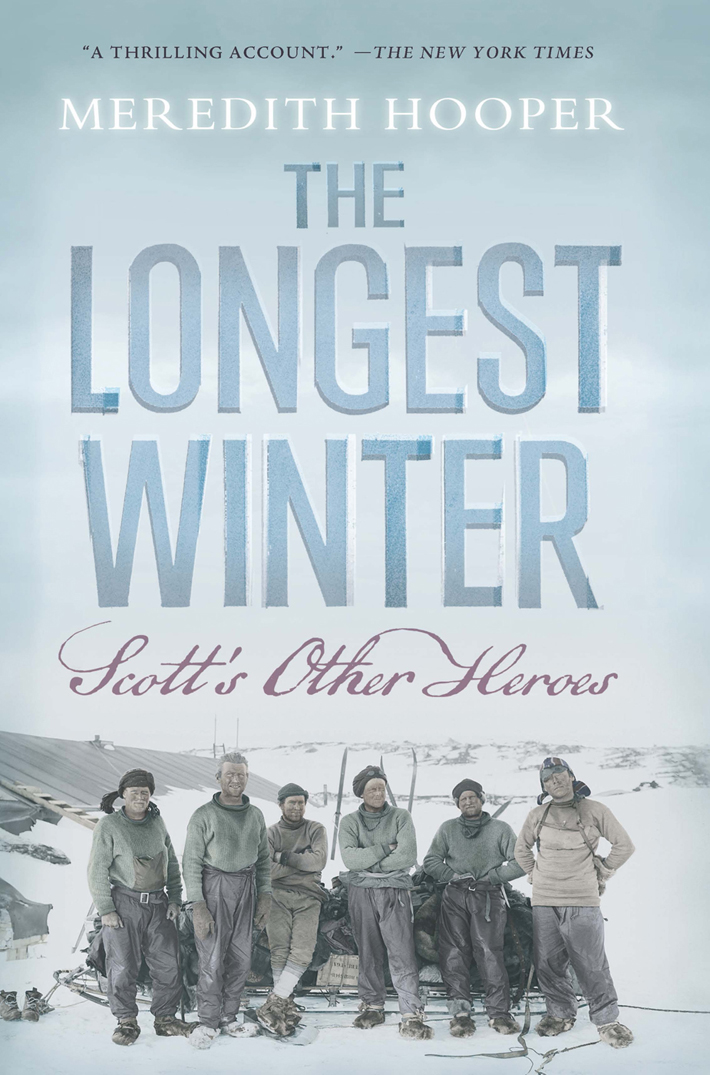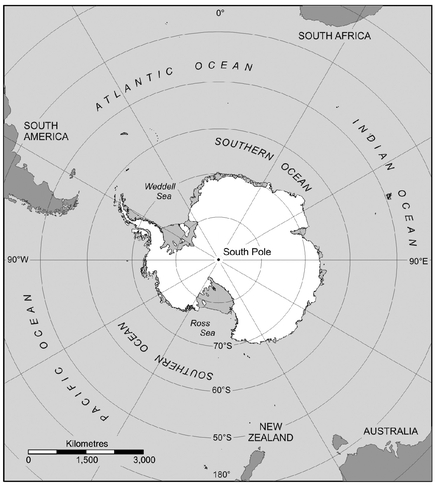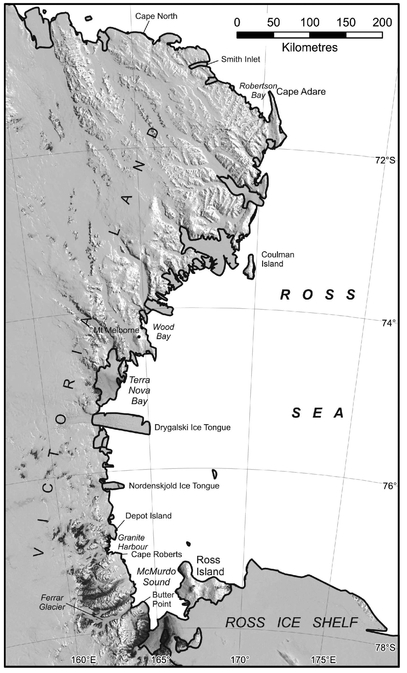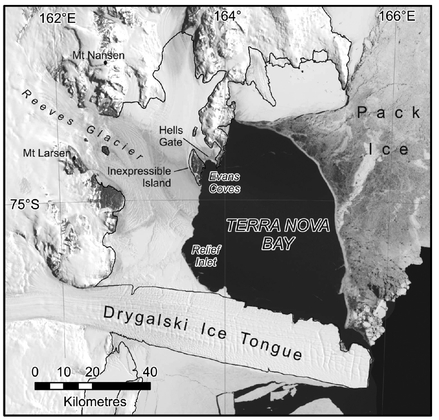Table of Contents
Guide
Table of Contents
A selection of other books by Meredith Hooper
The Ferocious Summer: Palmers Penguins and the Warming of Antarctica
A for Antarctica
Antarctic Journal: The Hidden Worlds of Antarcticas Animals
(with Lucia deLeiris)
The Pole-Seekers
History of Australia (with Manning Clark and Susanne Ferrier)
Doctor Hunger & Captain Thirst
Kangaroo Route
Cleared for Take-Off (with Tony Talifero)
Everyday Inventions
For Michael and Rachel
Map 1 Antarctica and the Southern Hemisphere
Map 2 The Ross Sea region of Antarctica
Map 3 Victoria Land, Antarctica, with locations mentioned in the text
Map 4 The area of Evans Coves where Campbells party landed on 8 January 1912 to begin exploring. In autumn unexpected, intense winds began sweeping down the Reeves Glacier from the inland ice sheet, across Inexpressible Island, where Campbell and his men were living in an ice-cave. The satellite image on which this map is based shows these winds clearing the pack ice out to sea, almost blocking access to Terra Nova Bay, as occurred in 1912.
Map 5 A satellite image of Ross Island, showing its relationship to the Ross Ice Shelf (the Barrier), and extensive sea ice in McMurdo Sound
A for Antarctica, all frost, ice and snow
the place where half witted explorers all go
B for the word they most frequently use
though not, we admit, without frequent excuse.
Murray Levick, written inside the cover of his ice-cave diary, 1912
The British Antarctic Expedition 1910 13
Characters and locations
CAPTAIN ROBERT FALCON Scott listed everyone on his British Antarctic Expedition under two headings: ship and shore. Departing New Zealand for Antarctica in November 1910, his expedition vessel Terra Nova had fifty-nine people on board. Thirty-one moved on shore when the ship anchored against the ice in January 1911, leaving twenty-eight in the ships party to take Terra Nova exploring and then return to New Zealand. Scott set up his winter quarters hut at Cape Evans on Ross Island (see Maps 2 and 5), in the angle of ice-filled ocean where the massive ice shelf men called the Barrier met the mountain ranges of Victoria Land. Scotts aim was to try and achieve the South Pole, and almost everyone in the shore party contributed to that goal in one way or another.
In line with Scotts long-planned objectives, the shore party was divided into an Eastern party and a Western party. The great majority, designated as the Western party, used the hut on Ross Island as their base. Those whom Scott selected to travel towards the Pole, in various supporting roles, became known as the Southern party, with the five who finally made the assault on the Pole being the Polar party. A small group of men detailed off to do geology on the Victoria Land coast (see Map 3), in the summer of 1911 and the summer of 1912, were designated Far West.
The Eastern party, consisting of six members, formed Scotts other expedition, with the task of establishing a second base to explore and do science while Scott concentrated on the Pole. Within three weeks of arriving at Cape Evans the party left, supplied for one or two years isolation with their own equipment, hut, food and two ponies to pull sledges. Their long-planned goal was to discover the nature of the land terminating the eastern end of the Barrier ice shelf, discovered by Scott in 1902, during his first Antarctic expedition (see Map 2). Scott had named his discovery King Edward VII Land, after the son of Queen Victoria, but no one had yet managed to get ashore.
The Eastern partys adventures and travels, in particular the long winter they spent at Evans Coves (see Maps 3 and 4), are the subject of this book. To everyone on Scotts expedition in Antarctica, the Eastern party was always called the Eastern party, whatever happened to them, wherever they were, even when their plans changed and they were sent north. However, unknown to anyone in Antarctica, the Eastern party was re-designated in London as the Northern party. Perhaps a letter from Wilfred Bruce, Kathleen Scotts bluff jovial brother, who served as a lieutenant on Terra Nova, initiated the change: alas, no longer Eastern!, he wrote to Kathleen, as Terra Nova took the Eastern party north. Terra Nova removed all the remaining members of Scotts expedition from Antarctica in January 1913. The Eastern party now found that back in London they had been re-designated as the Northern party. The new name replaced the old in all published documents, reports and accounts of the expedition.
This book tells the story of the Eastern party, as it happened, drawing on the participants diaries and journals. It therefore uses the name Eastern party. As far as Lieutenant Victor Campbell, Dr Murray Levick, Raymond Priestley, Petty Officer George Abbott, Petty Officer Frank Browning and Seaman Harry Dickason were concerned, they were, as they sang in their Eastern party sledging song:
Captain Scott his Eastern Party & were going strong.
Details of the Shore party, with their ages on the day of landing in Antarctica, Wednesday 4 January 1911, follow:
The Western party
Taken from the ships complement
Leader Captain Robert Falcon Scott CVO RN, known as The Owner, aged forty-two
Lieutenant Edward R. G. R. Evans RN, known as Teddy, aged twenty-nine
Lieutenant Henry R. Bowers RIM, known as Birdie, aged twenty-seven
Dr Edward L. Atkinson, Surgeon, RN, known as Atch, aged twenty-nine
Captain Lawrence E. G. Oates, 6th Inniskilling Dragoons, known as Titus, in charge of ponies, aged thirty
William Lashly, Chief Stoker, RN, aged forty-two
Robert Forde, Petty Officer, RN, aged thirty-five
Edgar Evans, Petty Officer, RN, aged thirty-four
Thomas Crean, Petty Officer, RN, aged thirty-three
Patrick Keohane, Petty Officer, RN, aged thirty-one
Thomas Clissold, Cook, RN, aged twenty-four
Frederick Hooper, Steward, RN, aged nineteen.
Scientists were led by the chief of the scientific staff, Dr Edward Adrian Wilson, zoologist, known as Uncle Bill, aged thirty-eight. They included:
Dr George C. Simpson, meteorologist, known as Sunny Jim, aged thirty-two


